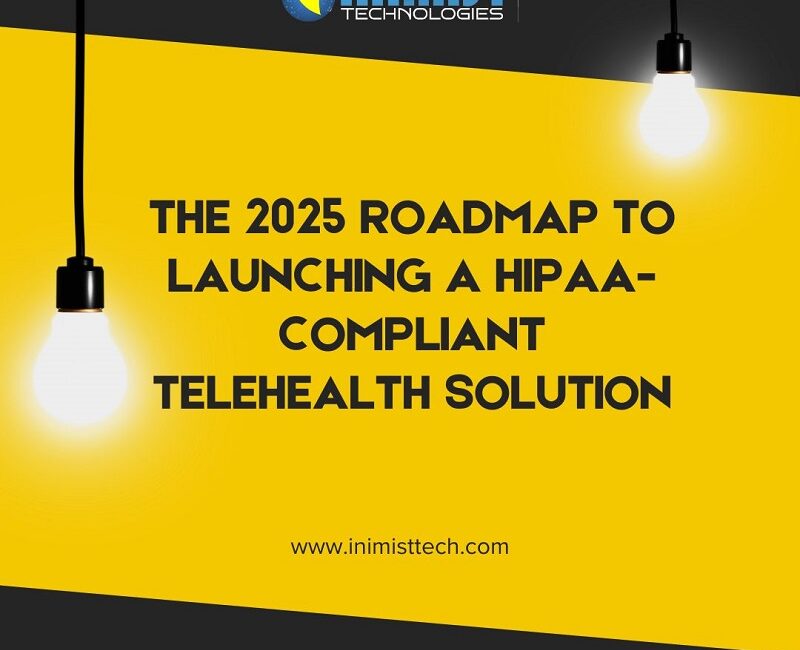The telehealth industry continues to grow rapidly, with increasing demand for secure, accessible, and compliant virtual care solutions. Ensuring HIPAA (Health Insurance Portability and Accountability Act) compliance for healthcare providers and digital health startups is critical to protecting patient data and avoiding legal penalties.
This roadmap outlines the key steps to successfully launch a HIPAA-compliant telehealth solution in 2025, covering technology, legal, and operational considerations.

Step 1: Understand HIPAA Requirements for Telehealth
Before building your solution, you must fully understand HIPAA’s Privacy, Security, and Breach Notification Rules. Key requirements include:
-
Protected Health Information (PHI) Safeguards: Ensure encryption for data at rest and in transit.
-
Access Controls: Implement role-based access to PHI.
-
Audit Logs: Track all access and modifications to patient data.
-
Business Associate Agreements (BAAs): Sign BAA’s with third-party PHI vendors.
Action Item: Conduct a HIPAA risk assessment to identify vulnerabilities in your planned solution.
Step 2: Choose the Right Technology Stack
Selecting a HIPAA-compliant infrastructure is crucial. Key components include:
A. Telehealth Platform Options
-
Build a Custom Solution: Offers full control but requires significant development and compliance efforts.
-
Use a HIPAA-Compliant Telehealth API/Framework: Vendors like Twilio (for video), AWS Chime, or Zoom for Healthcare provide pre-compliant tools.
-
White-Label Solutions: Platforms like Doxy.me or Amwell offer ready-to-deploy HIPAA-compliant telehealth services.
B. Hosting & Cloud Providers
-
HIPAA-Compliant Cloud Services: AWS, Google Cloud, and Microsoft Azure offer HIPAA-eligible services with signed BAAs.
-
On-Premises Hosting: Provides full control but requires stringent security measures.
C. Data Encryption & Security
-
End-to-End Encryption (E2EE): Mandatory for video, chat, and file transfers.
-
Secure APIs: Ensure APIs handling PHI follow OAuth 2.0 or similar authentication protocols.
Action Item: Select vendors that provide BAAs and have a proven track record in healthcare.
Step 3: Implement Strong Authentication & Access Controls
HIPAA requires strict access management to prevent unauthorized PHI exposure.
-
Multi-Factor Authentication (MFA): Required for all users (doctors, patients, admins).
-
Role-Based Access Control (RBAC): Define permissions (e.g., doctors can view records, receptionists can only schedule).
-
Single Sign-On (SSO): Integrate with EHR systems like Epic or Cerner for seamless logins.
Action Item: Integrate identity providers (e.g., Okta, Microsoft Entra ID) for secure authentication.
Step 4: Ensure Secure Patient-Provider Communication
Telehealth platforms must protect all communication channels:
-
Video Conferencing: Use WebRTC with E2EE or HIPAA-compliant SDKs (e.g., Vonage, Agora).
-
Messaging: Encrypted chat with auto-deletion of sensitive messages after a set period.
-
File Sharing: Secure document uploads with encryption (e.g., HIPAA-compliant Dropbox or custom solutions).
Action Item: Test all communication channels for vulnerabilities before launch.
Step 5: Integrate with EHR/EMR Systems
Seamless integration with Electronic Health Records (EHR) ensures continuity of care.
-
HL7/FHIR APIs: Standard protocols for EHR interoperability.
-
Custom EHR Integrations: Work with vendors like Epic, Cerner, or Athenahealth.
-
Patient Portals: Allow patients to access visit summaries and medical records securely.
Action Item: Partner with EHR vendors early to streamline integration.
Step 6: Conduct Rigorous Testing & Compliance Audits
Before launch, validate security and compliance through:
-
Penetration Testing: Hire ethical hackers to identify vulnerabilities.
-
HIPAA Security Risk Assessment: Document all safeguards and risks.
-
Compliance Audits: Engage a third-party auditor to certify HIPAA adherence.
Action Item: Fix all identified gaps and document remediation steps.
Step 7: Train Staff & Establish Policies
Human error is a leading cause of HIPAA violations.
-
Staff Training: Educate employees on HIPAA rules, phishing risks, and data handling.
-
Incident Response Plan: Define steps for breach notification (must report within 60 days).
-
Regular Policy Reviews: Update security policies annually or after major changes.
Action Item: Conduct mock breach drills to ensure readiness.
Step 8: Launch & Monitor Continuously
Post-launch, maintain compliance through:
-
Real-Time Monitoring: Use SIEM tools (e.g., Splunk, IBM QRadar) to detect breaches.
-
Regular Audits: Conduct quarterly security assessments.
-
Patient Feedback: Improve UX while maintaining compliance.
Action Item: Set up automated alerts for suspicious activity.
Conclusion
Launching a HIPAA-compliant telehealth solution in 2025 requires a structured approach—from selecting secure technology to training staff and continuous monitoring. By following this roadmap, healthcare providers and digital health innovators can deliver secure, scalable, and compliant telehealth services while building patient trust.
Next Steps:
-
Conduct a HIPAA risk assessment.
-
Choose compliant vendors and sign BAAs.
-
Develop and test your platform with security in mind.
-
Train your team and prepare for audits.
With the right strategy, your telehealth solution can thrive in the evolving digital healthcare landscape.
Read Also:
Beauty Meets Tech: The Essentials of Mobile Apps in the Wellness Industry
Revolutionizing Healthcare: The Impact of Mobile Apps on the Medical Industry
Also Visit:
https://inimisttech.com/


Leave a Reply